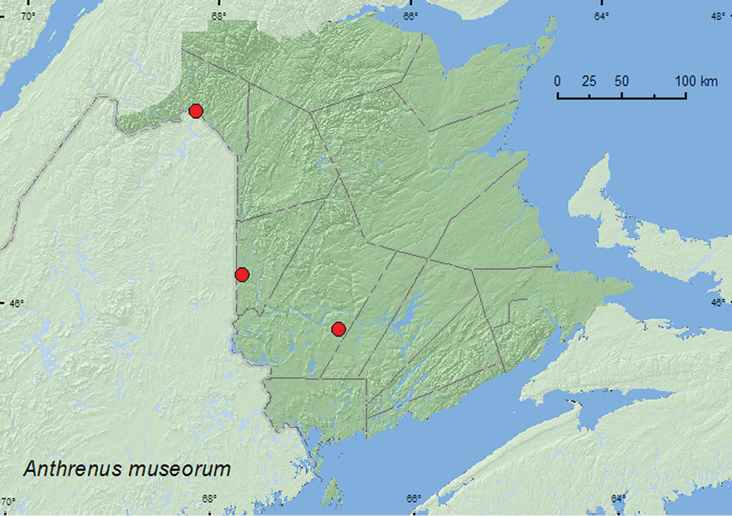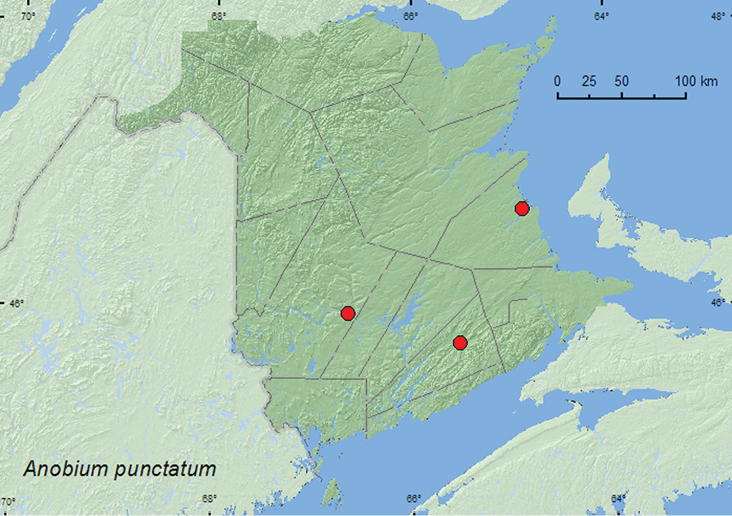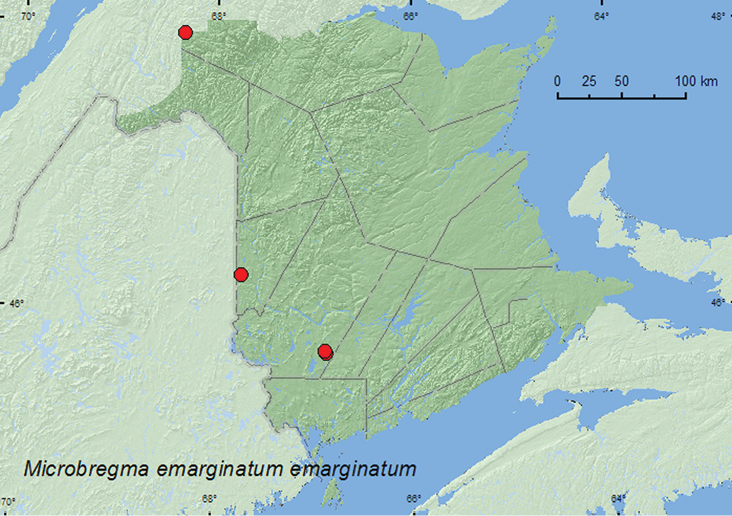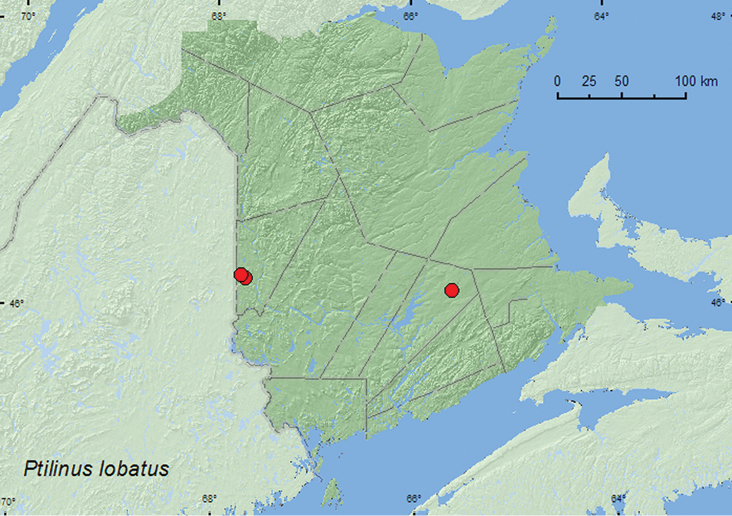






(C) 2012 Reginald P. Webster. This is an open access article distributed under the terms of the Creative Commons Attribution License 3.0 (CC-BY), which permits unrestricted use, distribution, and reproduction in any medium, provided the original author and source are credited.
For reference, use of the paginated PDF or printed version of this article is recommended.
We report ten new species records for the Coleoptera fauna of New Brunswick, Canada from the families Dermestidae, Endecatomidae, Bostrichidae, and Ptinidae. Anthrenus fuscus Olivier and Anthrenus museorum (Linnaeus) of the family Dermestidae are newly recorded for New Brunswick. Endecatomus rugosus (Randall) and the family Endecatomidae are recorded for the first time for New Brunswick and the Maritime provinces. Two Bostrichidae, the adventive Dinoderus minutus (Fabricius) and the native Stephanopachys substriatus (Paykull), are newly recorded for the province. Five species of Ptinidae, the adventive Anobium punctatum (DeGeer) and Microbregma emarginatum emarginatum (Duftschmid), and the native Hadrobregmus notatus (Say), Ptilinus lobatus Casey, and Ptilinus ruficornis Say are added to the faunal list of New Brunswick. Collection data, habitat data, and distribution maps are presented for all these species.
Dermestidae, Endecatomidae, Bostrichidae, Ptinidae, Canada, New Brunswick, new records
This paper treats new species records from New Brunswick, Canada of the Coleoptera families Dermestidae, Endecatomidae, Bostrichidae, and Ptinidae. The fauna of these families from New Brunswick and the Maritime provinces (New Brunswick, Nova Scotia, Prince Edward Island) was recently treated by
The following records are based, in part, on specimens collected as part of a general survey by the first author to document the Coleoptera fauna of New Brunswick and from a study to develop improved lures for survey of potentially invasive species of Cerambycidae. Additional records were obtained from specimens contained in the collection belonging to Natural Resources Canada, Canadian Forest Service - Atlantic Forestry Centre, Fredericton, New Brunswick.
Collection methodsVarious methods were employed to collect the specimens reported in this study. Details are outlined in
Distribution maps, created using ArcMap and ArcGIS, are presented for each species in New Brunswick. Every species is cited with current distribution in Canada and Alaska, using abbreviations for the state, provinces, and territories. New records for New Brunswick are indicated in bold under Distribution in Canada and Alaska. The following abbreviations are used in the text:
| AK | Alaska | MB | Manitoba |
| YT | Yukon Territory | ON | Ontario |
| NT | Northwest Territories | QC | Quebec |
| NU | Nunavut | NB | New Brunswick |
| BC | British Columbia | PE | Prince Edward Island |
| AB | Alberta | NS | Nova Scotia |
| SK | Saskatchewan | NF & LB | Newfoundland and Labrador* |
*Newfoundland and Labrador are each treated separately under the current Distribution in Canada and Alaska.
Acronyms of collections examined or where specimens reside referred to in this study are as follows:
AFC Atlantic Forestry Centre, Natural Resources Canada, Canadian Forest Service, Fredericton, New Brunswick, Canada
CNC Canadian National Collection of Insects, Arachnids and Nematodes, Agriculture and Agri-Food Canada, Ottawa, Ontario, Canada
MTC Martin Turgeon Collection, Sainte-Basile, New Brunswick, Canada
NBM New Brunswick Museum, Saint John, New Brunswick, Canada
RWC Reginald P. Webster Collection, Charters Settlement, New Brunswick, Canada
UMNB Université de Moncton Collection, Moncton, New Brunswick, Canada
Results Species accountsAll records below are species newly recorded for New Brunswick, Canada. Species followed by ** are newly recorded from the Maritime provinces of Canada.
The classification of the Dermestidae, Endecatomidae, Bostrichidae, and Ptinidae follows
The Dermestidae (skin beetles) are generally scavengers, feeding on dried animal materials such as dried carcasses, old feathers, and plant materials with high protein content (
New Brunswick, Madawaska Co., St.-Basile, 7.V.1999, M. Turgeon (1, MTC). Westmorland Co., Smith Brook, 21.VII.1995, M. Turgeon (1, MTC).
Map 1. Collection localities in New Brunswick, Canada of Anthrenus fuscus
This adventive Palaearctic species is a minor pest in flour mills, warehouses, and homes (
ON, QC, NB, NS, PE (
New Brunswick, Carleton Co., Jackson Falls, Bell Forest, 46.2210°N, 67.7210°W, 25.VI.2007, R. P. Webster, mature hardwood forest, sweeping foliage (1, RWC). Madawaska Co., St.-Basile, 7.V.1999, M. Turgeon, in insect collection (1, MTC); same locality and collector, 29.V.2010 (1, MTC). York Co., Charters Settlement, 45.8395°N, 66.7391°W, 19.VI.2004, 14.VI.2008, R. P. Webster, mixed forest, on flowers of mountain ash and an ornamental Spiraea (7, RWC).
Map 2. Collection localities in New Brunswick, Canada of Anthrenus museorum.
Anthrenus museorum adults were collected from flowers of mountain ash (Sorbus sp.) and an ornamental Spiraea, and by sweeping foliage in a mature hardwood forest. One adult was found in an insect collection. Adults were captured during May and June. The larvae of this household pest feed on wool, fur, skins, museum specimens, and other animal products. Adults feed on nectar and pollen (
ON, QC, NB, PE, NS, NF (
The Endecatomidae is a small monogeneric family with four Holarctic species.
New Brunswick, Carleton Co., Hartland, Becaguimec Island (in Saint John River), 46.3106°N, 67.5372°W, 13.IX.2006, R. P. Webster, old mixed forest, in large dried polypore fungus (1, RWC).
Map 3. Collection localities in New Brunswick, Canada of Endecatomus rugosus.
One individual of this species was collected from a large old and dried polypore fungus on a partially dead basswood (Tilia americana L.) in an old mixed forest.
MB, ON, QC, NB (
Larvae of most species of Bostrichidae (the bostrichid beetles) are wood borers and receive their nutrition from the starch content of wood they consume (
New Brunswick, Albert Co., Riverview Heights, (no day).VIII.1971, (no collector given) ex. carved wood statue and basket (2, AFC).
Map 4. Collection localities in New Brunswick, Canada of Dinoderus minutus.
This adventive species is often found in warehouses and places where bamboo products are stored (
BC, SK, MB, ON, NB, PE (
http://species-id.net/wiki/Stephanopachys_substriatus
Map 5New Brunswick, Sunbury Co., Acadia Research Forest, 45.9866°N, 66.3841°W, 9–16.VI.2009, R. Webster & M.-A. Giguère, mature (110-year-old) red spruce forest with scattered red maple and balsam fir, Lindgren funnel trap (1, RWC). York Co., 15 km W of Tracy off Rt. 645, 45.6848°N, 66.8821°W, 15–21.VI.2010, R. Webster & M.-A. Giguère, old red oak forest, Lindgren funnel trap (1, AFC).
Map 5. Collection localities in New Brunswick, Canada of Stephanopachys substriatus.
The two individuals from New Brunswick were captured during June in Lindgren funnel traps in a red spruce (Picea rubens Sarg.) forest and an old red oak (Quercus rubra L.) forest. Members of this genus are associated with conifers (
AK, YK, NT, BC, AB, MB, ON, QC, NB, NS (
The Ptinidae (death watch and spider beetles) (formerly Anobiidae) are borers in bark, dry wood, twigs, galls, pine cones, and fungi (many Anobiinae) or feed on accumulated dried animal and plant material, and are found in bird, mammal, and solitary bee nests (mostly Ptininae) (
New Brunswick, Kent Co., Richibucto, 2.VII.1989, P. Maltais (1, UMNB). Kings Co., Sussex, 13.IX.1957, C.C. Smith, from barn timbers (3, AFC). York Co., Fredericton, 24.I.1934, ex. seasoned wood (3, AFC).
Map 6. Collection localities in New Brunswick, Canada of Anobium punctatum.
Known as the furniture beetle, this adventive species feeds on a variety of soft- and hardwood species (
BC, AB, MB, QC, NB, NS, NF (
http://species-id.net/wiki/Microbregma_emarginatum_emarginatum
Map 7New Brunswick, Carleton Co., Jackson Falls, Bell Forest, 46.2200°N, 67.7231°W, 12–19.VI.2008, 27.VI–5.VII.2008, R. P. Webster, mature hardwood forest, Lindgren funnel traps (2, RWC). Restigouche, Co., Dionne Brook P.N.A. (Protected Natural Area), 47.9064°N, 68.3441°W, 31.V–15.VI.2011, 15–27.VI.2011, M. Roy & V. Webster, old-growth white spruce and balsam fir forest, Lindgren funnel traps (7, AFC, NBM, RWC). York Co., 14 km WSW of Tracy, S of Rt. 645, 45.6741°N, 66.8661°W, 10–26.V.2010, 2–16.VI.2010, R. Webster & C. MacKay, old mixed forest with red and white spruce, red and white pine, balsam fir, eastern white cedar, red maple, and Populus sp., Lindgren funnel trap (2, RWC); 15 km W of Tracy off Rt. 645, 45.6848°N, 66.8821°W, 8–20.VI.2011, M. Roy & V. Webster, old red pine forest, Lindgren funnel traps (3, AFC, RWC).
Map 8. Collection localities in New Brunswick, Canada of Hadrobregmus notatus.
In New Brunswick, adults of this species were captured in Lindgren funnel traps in a hardwood forest with sugar maple (Acer saccharum Marsh.), American beech (Fagus grandifolia Ehrh.), white ash (Fraxinus americana L.), and small areas of eastern hemlock (Tsuga canadensis (L.) Carr.) and eastern white cedar (Thuja occidentalis L.), an old mixed forest with red spruce, white spruce (Picea glauca (Moench) Voss), red pine (Pinus resinosa Ait.), white pine (Pinus strobus L.), balsam fir (Abies balsamea (L.) Mill., eastern white cedar, red maple (Acer rubrum L.), and Populus sp., an old red pine forest, and an old-growth white spruce and balsam fir forest.
BC, AB, SK, MB, ON, QC, NB, PE, NS (
New Brunswick, Carleton Co., Jackson Falls, Bell Forest, 46.2200°N, 67.7231°W, 12–19.VI.2008, R. P. Webster, mature hardwood forest, Lindgren funnel trap (1, RWC). Queens Co., Cranberry Lake P.N.A., 46.1125°N, 65.6075°W, 18–25.VI.2009, 15–21.VII.2009, 28.VII–6.VIII.2009, R. Webster & M.-A. Giguère, mature red oak forest, Lindgren funnel traps (5, AFC, RWC). Sunbury Co., Acadia Research Forest, 45.9866°N, 66.3841°W, 19–25.V.2009, 9–16.VI.2009, 16–24.VI.2009, 24–30.VI.2009, 30.VI-8.VII.2009, R. Webster & M.-A. Giguère, mature (110-year-old) red spruce forest with scattered red maple and balsam fir, Lindgren funnel traps (6, AFC, RWC). York Co., Fredericton, 9.X.1958, C. C. Smith, ex. Picea glauca (2, AFC); 15 km W of Tracy off Rt. 645, 45.6848°N, 66.8821°W, 15–21.VI.2010, 21–28.VI.2009, 28.VI–7.VII.2009, 14–20.VII.2009, 20–29.VII.2009, 11–18.VIII.2009, R. Webster & M.-A. Giguère, old red pine forest, Lindgren funnel traps (9, AFC, RWC); 14 km WSW of Tracy, S of Rt. 645, 45.6741°N, 66.8661°W, 16–30.VI.2010, R. Webster & C. MacKay, old mixed forest with red and white spruce, red and white pine, balsam fir, eastern white cedar, red maple, and Populus sp., Lindgren funnel traps (2, AFC).
Map 7. Collection localities in New Brunswick, Canada of Microbregma emarginatum emarginatum.
In New Brunswick, this species was captured in Lindgren funnel traps in a mature hardwood forest with sugar maple, American beech, and white ash, an old red oak forest, an old mixed forest, a mature red spruce forest with scattered red maple and balsam fir, and an old red pine forest. Two individuals were reared from white spruce.
ON, QC, NB, PE, NS (
New Brunswick, Carleton Co., Meduxnekeag Valley Nature Preserve, 46.1931°N, 67.6825°W, 20.VI.2005, M.-A. Giguère, floodplain forest with butternut, on trunk of Prunus serotina (2, RWC); Jackson Falls, Bell Forest, 46.2200°N, 67.7231°W, 21–28.VI.2009, R. Webster & M.-A. Giguère, mature hardwood forest, Lindgren funnel trap (1, AFC). Queens Co., Cranberry Lake P.N.A., 46.1125°N, 65.6075°W, 1–10.VII.2009, R. Webster & M.-A. Giguère, old red oak forest, Lindgren funnel trap (1, RWC).
Map 9. Collection localities in New Brunswick, Canada of Ptilinus lobatus.
Specimens from New Brunswick were captured from Lindgren funnel traps in a mature hardwood forest with sugar maple, American beech, and white ash, and an old red oak forest. Two specimens were collected from the trunk of a black cherry (Prunus serotina Ehrh.) in a floodplain forest with butternut (Juglans cinerea L.). The larvae of Ptilinus species mine hardwoods (
YK, BC, AB, MB, ON, NB, NS (
New Brunswick, Carleton Co., North Richmond (now probably Richmond Corner), 20.VI.1942, R. E. Currie, beating balsam fir foliage, F.I. Survey 42-L113 (1, AFC); Jackson Falls, Bell Forest, 46.2200°N, 67.7231°W, 5–12.VII.2008, R. P. Webster, mature hardwood forest, Lindgren funnel trap (1, RWC); same locality and habitat data but 21–28.VI.2009, 28.VI–7.VII.2009, R. Webster & M.-A. Giguère, Lindgren funnel traps (9, AFC, RWC). Charlotte Co., 10 km NW of New River Beach, 45.2110°N, 66.6170°W, 29.VI-16.VII.2010, R. Webster & C. MacKay, old growth eastern white cedar forest, Lindgren funnel trap (1, AFC). Queens Co., Cranberry Lake P.N.A., 46.1125°N, 65.6075°W, 18–25.VI.2009, 10–15.VII.2009, R. Webster & M.-A. Giguère, old red oak forest, Lindgren funnel traps (2, RWC); Grand Lake Meadows P.N.A., 45.8227°N, 66.1209°W, 19.VII–5.VIII.2011, M. Roy & V. Webster, old silver maple forest with green ash and seasonally flooded marsh, Lindgren funnel trap (1, NBM). Saint John Co., Fairville Plateau, 30.VI.1949, from house, (9, AFC). Sunbury Co., Acadia Research Forest, 45.9866°N, 66.3841°W, 24–30.VI.2009, R. Webster & M.-A. Giguère, mature (110-year-old) red spruce forest with scattered red maple and balsam fir, Lindgren funnel trap (1, RWC). York Co., 15 km W of Tracy off Rt. 645, 45.6848°N, 66.8821°W, 15–21.VI.2009, 21–28.VI.2009, 28.VI–7.VII.2009, R. Webster & M.-A. Giguère, old red pine forest, Lindgren funnel traps (3, AFC); same locality and habitat data, 16–30.VI.2010, 30.VI–13.VII.2010, R. Webster, C. MacKay, & K. Burgess, Lindgren funnel traps (3, AFC, RWC).
Map 10. Collection localities in New Brunswick, Canada of Ptilinus ruficornis.
Ptilinus ruficornis occurred in various deciduous and coniferous forest types in New Brunswick. This species was captured in a mature hardwood forest with sugar maple, American beech, and white ash, an old red oak forest, an old silver maple (Acer saccharinum L.) forest, an old red pine forest, a mature (110-year-old) red spruce forest with scattered red maple and balsam fir, and an old-growth eastern white cedar forest/swamp. Most adults were captured in Lindgren funnel traps; one individual was beaten from balsam fir foliage. The larvae of Ptilinus sp. mine hardwoods (
AB, ON, QC, NB, NS (
We thank Caroline Simpson (AFC) for editing this manuscript. Chris Majka is thanked for reviewing the manuscript and supplying additional data for several species. Serge Laplante (Agriculture and Agri-Food Canada (CNC), Ottawa) is thanked for determining specimens. We thank Nichole Brawn, Katie Burgess, Marie-Andrée Giguère, Nancy Harn, Cory Hughes, Colin MacKay, Wayne MacKay, Jessica Price, Michelle Roy, and Vincent Webster for technical assistance and collecting specimens. Natural Resources Canada, Canadian Forest Service; the Canadian Food Inspection Agency; and the USDA APHIS are thanked for funding the study on early detection of invasive cerambycids, which provided many specimens collected in Lindgren funnel traps. We thank the New Brunswick Environmental Trust Fund and New Brunswick Wildlife Trust Fund for funding various insect surveys over the past 6 years, and the Meduxnekeag River Association for permission to sample beetles at the Meduxnekeag Valley Nature Preserve (which includes the Bell Forest. The New Brunswick Department of Natural Resources (Fish and Wildlife Branch) is thanked for issuing permits for sampling in the Protected Natural Areas and for providing logistical support.









